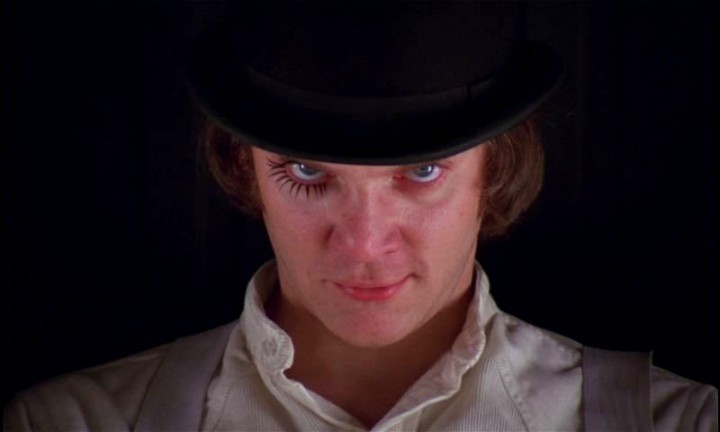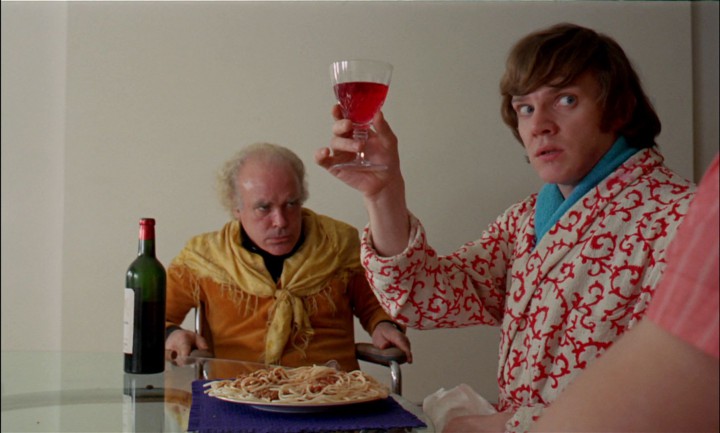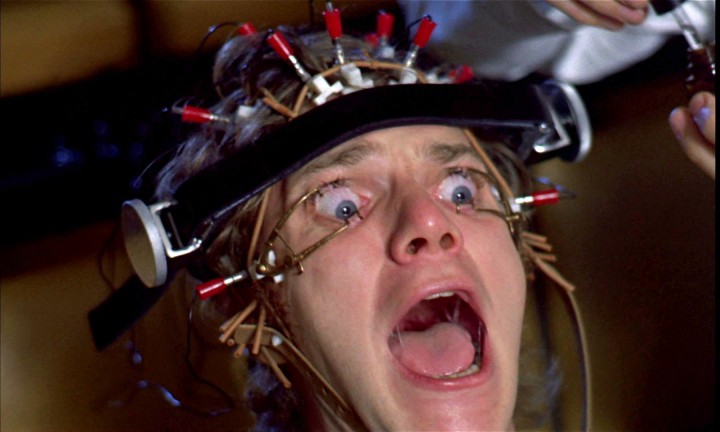Stanley Kubrick’s A Clockwork Orange (1971) is one of those rare films—like Edgar G. Ulmer’s The Black Cat (1934), Ken Russell’s The Devils (1971), Sam Peckinpah’s Straw Dogs—that manages to retain the controversy surrounding its original release despite the passage of time. That might seem a small accomplishment, but really what is generally more old hat than last year’s controversy? Yet, here we have a film that has managed to keep the controversy going for 43 years and still counting. We might be past the shock of the originally X-rated (later downgrade to an R) film snagging a Best Picture nomination from the Oscar folks, but you can go to the IMDb message boards this very minute and find people still fighting over whether or not A Clockwork Orange is a work of art or merely an exercise in stylized violence and ugliness. It was, of course, very much of its time — the era of superstar director and those years when those same directors were testing just how far they could take the new permissiveness of the ratings system that had only come into existence in 1968. (That many of these films were made in Great Britain and outside the realm of the so-called “New Hollywoof,” they all had US ditribution deals — and sometimes US money — and were reliant on those MPAA ratings.)
For that matter, the story of Alex (Malcolm McDowell), his crimes against society, his imprisonment, his radical “cure,” the vengeance exacted on him by someone he wronged and his ultimate re-empowerment is one that took me years to come to terms with. It was at a showing—easily the sixth or seventh time I’d seen the film—in the late 1970s when the film came into focus for me. The film was playing at the old Great Southern Music Hall (a combination concert venue and rep house) in Orlando, Fla. and the volume was turned way up (as I believe it ought to be with this film) and suddenly things that seemed awkward and overstated (like Patrick Magee’s ripe Boris Karloff impression lunacy) fell into place, and I realized that much of the film is meant to be taken as pitch-black—even heartless—comedy.
That’s only part of the film, of course, but it’s essential to understanding the movie’s operatic nature and thematic points about freewill, the inherent insanity (and duplicity) of either end of the political spectrum and, very significantly, that we get out of great art pretty much only what we bring to it. I strongly suspect that last was — and is — a primary reason for why the film so upset people. Questioning the idea that art automatically elevates those who are exposed to it strikes at a very fundamental societal belief. But I believe that Kubrick was hurling his javelin as much into the future as a comment on then-current times. And considering that we now live in a world where a great deal of pretty disposable pop culture is being hailed as important art, we may be much nearer the tip of that javelin than the audiences of 1971.
Technically, the film is a marvel. It’s easily Kubrick’s best and boldest work, which may have something to do with the fact that he didn’t overcook it, making it for a relatively small budget in a comparatively short amount of time (a year from the start of shooting to release — the equivalent of a six-week-shoot for Kubrick). The lighting, the camerawork, the matching of music to image all come together to provide a cinematic kick that still resonates. It remains as much of an event as it ever did. From the moment the screen fills with red and the sound of Walter (Wendy) Carlos’ synthesized take on Henry Purcell’s “Funeral March for Queen Mary” floods the theater — followed by the minimal and stark credits — you realize that this is something special. And that keeps up through the startling first shot of Malcolm McDowell’s Alex and the slow, elegant pull-back shot of the milk bar. In fact, it retains that sense of being something other than an ordinary movie for its entire length — whether what it shows us is chilling, vaguely disturbing, oddly beautful, bleakly comic, or downright horrifying. It is truly an essential.
The Asheville Film Society is showing A Clockwork Orange Wednesday, May 14, at 7:30 p.m. in at The Carolina Asheville as part of the Budget Big Screen series. Admission is $5 for AFS members and $7 for the general public.








Tickets are now on sale. Since Kubrick is traditionally a big draw, I wouldn’t wait till the last minute.